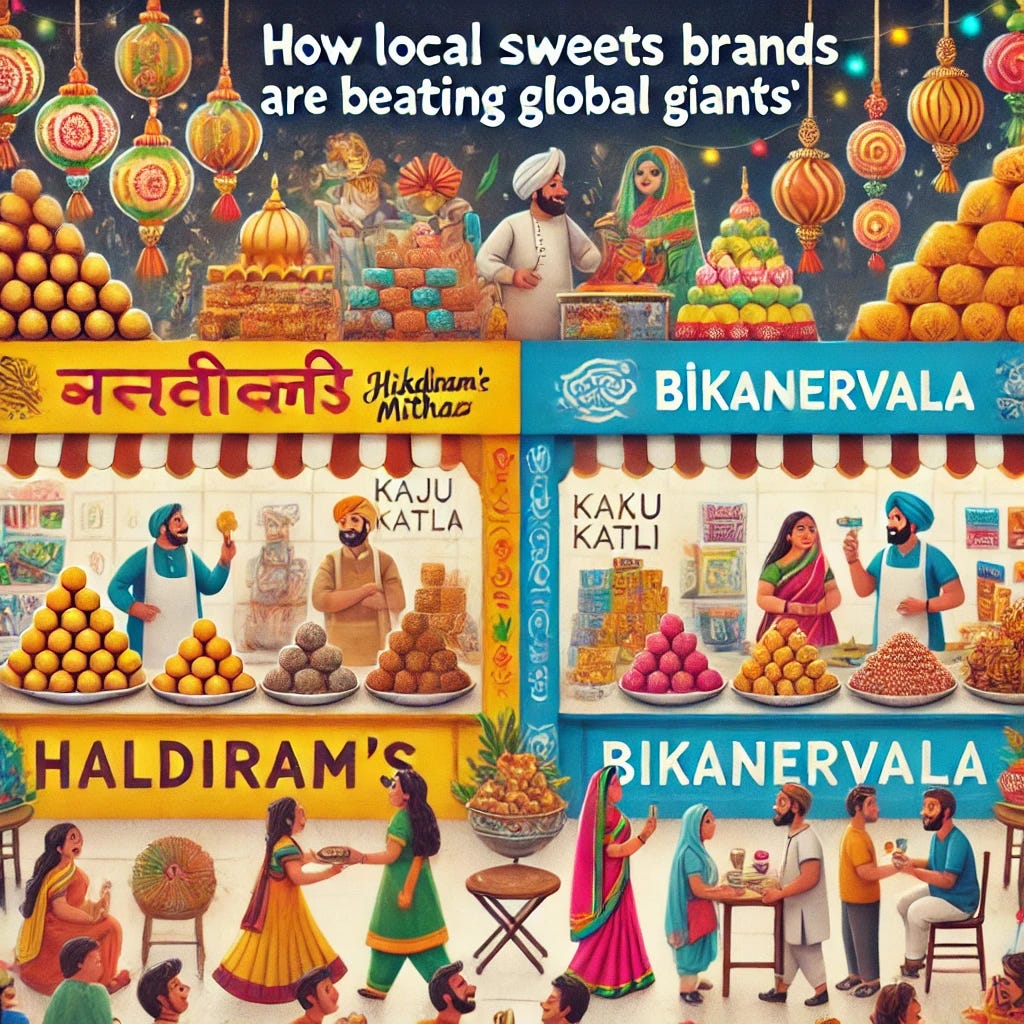How Local Sweets Brands Are Beating Global Giants in the Dessert Market?
thinking of Haldiram?
Did you know that the humble laddoo is giving global giants like KitKat and Ferrero Rocher a run for their money? Yes, the same mithai that graces our festivals and family gatherings is now an empire-builder for Indian brands like Haldiram’s, Bikanervala, and Balaji Wafers.
But before we start, here’s a dose of positivity for you:
Take 10 minutes to brainstorm one creative idea to solve a challenge you’re facing
Now, let’s get started…
The ‘Sweet’ Economy
In India, sweets are more than just desserts; they’re emotions, traditions, and sometimes, even status symbols. With an annual mithai market estimated at over ₹1.25 lakh crore, the competition is fierce, yet Indian brands are thriving. How? By combining tradition with innovation.
Case Study 1: Haldiram’s
Haldiram’s began in 1937 as a small shop in Bikaner, Rajasthan. Fast-forward to today, it’s a global powerhouse with over ₹10,000 crore in annual revenue, dwarfing the sales of many international confectionery brands in India.
Secret Recipe for Success:
Diversification: While traditional mithai remains their backbone, Haldiram’s expanded into namkeens, cookies, and even Western snacks like potato chips.
Ready-to-Eat Packaging: They modernized mithai with longer shelf lives, making products like soan papdi and gulab jamuns accessible worldwide.
Cultural Relevance: Whether it’s Diwali hampers or Holi gift packs, Haldiram’s taps into India’s festival economy like no other.
Case Study 2: Bikanervala
Another Bikaner-born brand, Bikanervala, is known for its focus on the dine-in experience. With over 100 outlets globally, they’ve redefined the concept of mithai shops by integrating them with casual dining restaurants.
Key Moves:
Experience First: Walk into any Bikanervala, and you’ll find a combination of a mithai counter and a sit-down restaurant, catering to both sweet tooths and full meals.
International Expansion: Their outlets in Dubai, Singapore, and the U.S. cater to NRIs who crave authentic Indian mithai.
Premium Offerings: By introducing gourmet options like sugar-free sweets and exotic flavors, they’ve attracted health-conscious and experimental consumers.
How Local Beats Global?
1. Deep Cultural Connections:
Global giants like Ferrero Rocher or Cadbury struggle to replicate the emotional connection Indians have with their sweets. A kaju katli on Diwali or a motichoor laddoo at a wedding holds a cultural significance that no chocolate can match.
Example:
During Raksha Bandhan, mithai brands launch specially curated boxes tailored to the festival, a strategy global brands often overlook.
2. Affordability and Accessibility:
Unlike global chocolates, which are often seen as premium, local mithai is available at price points that cater to every Indian household. From a ₹10 peda to a ₹5,000 wedding platter, there’s something for everyone.
Example:
Balaji Wafers, though primarily a snack brand, taps into the rural economy with low-cost mithai packs for small-town celebrations.
3. Customization and Variety:
Indian mithai brands excel at offering a variety of sweets tailored to regional and seasonal preferences. For instance, Bengali brands like K.C. Das specialize in rasgullas and sandesh, while down South, Mysore Pak is a must-have.
Example:
Haldiram’s launched mango-flavored sweets during the summer, capitalizing on India’s love for seasonal fruits.
4. Technology Meets Tradition
Indian mithai brands have embraced technology to scale their operations. From e-commerce platforms to advanced packaging techniques, these brands are ensuring their products meet the demands of a modern, global consumer base.
Example:
Haldiram’s: Offers its products on platforms like Amazon, ensuring that a box of kaju katli can be delivered from Jaipur to New York with ease.
Zomato & Swiggy Partnerships: Many mithai shops now deliver directly through food apps, making sweets as accessible as pizzas.
Challenges Ahead
While local brands dominate the market, they face challenges like increasing competition, quality consistency, and a shift toward Western desserts among younger consumers. However, their adaptability and cultural grounding keep them ahead.
Example:
To counter the health-conscious trend, brands like Bikanervala are introducing sugar-free and vegan mithai options.
Sweet Lessons for Entrepreneurs
Local mithai brands offer plenty of lessons for budding entrepreneurs:
🍰 Understand Your Audience: Know their preferences, needs, and pain points.
🍰 Leverage Local Culture: Incorporate cultural elements that resonate with your target market.
🍰 Embrace Technology: Use digital platforms to scale operations and reach new audiences.
🍰 Innovate Constantly: Introduce new products while preserving your brand’s traditional essence.
The success of brands like Haldiram’s and Bikanervala shows that Indian mithai is not just a product but a cultural powerhouse. By staying true to their roots while embracing modern business practices, these brands have carved a unique identity that global giants struggle to replicate.
So, the next time you savor a peda or a jalebi, remember: you’re tasting not just sweetness but a legacy that’s conquering the world, one bite at a time.
So, that’s it from me today. What are your views? Share it in the comments, and let’s learn something from each other.
See ya 👋


